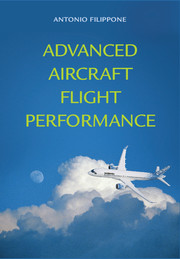Book contents
- Frontmatter
- Contents
- Tables
- Preface
- Nomenclature
- Technology Warning
- 1 Prolegomena
- 2 Aircraft Models
- 3 Weight and Balance Performance
- 4 Aerodynamic Performance
- 5 Engine Performance
- 6 Propeller Performance
- 7 Airplane Trim
- 8 Flight Envelopes
- 9 Take-Off and Field Performance
- 10 Climb Performance
- 11 Descent and Landing Performance
- 12 Cruise Performance
- 13 Manoeuvre Performance
- 14 Thermo-Structural Performance
- 15 Mission Analysis
- 16 Aircraft Noise: Noise Sources
- 17 Aircraft Noise: Propagation
- 18 Aircraft Noise: Flight Trajectories
- 19 Environmental Performance
- 20 Epilogue
- Appendix A Gulfstream G-550
- Appendix B Certified Aircraft Noise Data
- Appendix C Options for the FLIGHT Program
- Index
- References
16 - Aircraft Noise: Noise Sources
Published online by Cambridge University Press: 05 January 2013
- Frontmatter
- Contents
- Tables
- Preface
- Nomenclature
- Technology Warning
- 1 Prolegomena
- 2 Aircraft Models
- 3 Weight and Balance Performance
- 4 Aerodynamic Performance
- 5 Engine Performance
- 6 Propeller Performance
- 7 Airplane Trim
- 8 Flight Envelopes
- 9 Take-Off and Field Performance
- 10 Climb Performance
- 11 Descent and Landing Performance
- 12 Cruise Performance
- 13 Manoeuvre Performance
- 14 Thermo-Structural Performance
- 15 Mission Analysis
- 16 Aircraft Noise: Noise Sources
- 17 Aircraft Noise: Propagation
- 18 Aircraft Noise: Flight Trajectories
- 19 Environmental Performance
- 20 Epilogue
- Appendix A Gulfstream G-550
- Appendix B Certified Aircraft Noise Data
- Appendix C Options for the FLIGHT Program
- Index
- References
Summary
Overview
The subject of aircraft noise is too vast to be covered in a single chapter; thus, we focus on those issues that are required for a low-order simulation of aircraft noise emission and propagation. The chapter is organised as follows: We first discuss the importance of the subject (§ 16.1) and introduce basic definitions that are used to characterise aircraft noise (§ 16.2). We then establish the framework for the development of an aircraft-noise program that is synchronised with the flight mechanics (§ 16.3). The sources of noise are split into propulsive (§ 16.4) and non-propulsive components (§ 16.6). We include a discussion of the APU noise as a separate item (§ 16.5). The propeller-noise model (§ 16.7) is discussed in isolation from airframe and engines. Chapter 17 deals with propagation effects. Chapter 18 deals with noise trajectories.
KEY CONCEPTS: Sound, Noise Metrics, Engine Noise, Airframe Noise, Propeller Noise, APU Noise, Aircraft-Noise Model.
Introduction
In the beginning there was silence, or so the story goes. Then came human activities and jet engines. This is when the noise started to hurt. Low-flying aircraft cause nasty physiological effects and are bad for your well-being. To be fair, noise pollution is just one of many environmental issues that face the aviation industry; it is part of the larger context of local air quality, combustion emissions, environmental compatibility, policies and regulations and public health.
- Type
- Chapter
- Information
- Advanced Aircraft Flight Performance , pp. 470 - 532Publisher: Cambridge University PressPrint publication year: 2012
References
- 3
- Cited by

